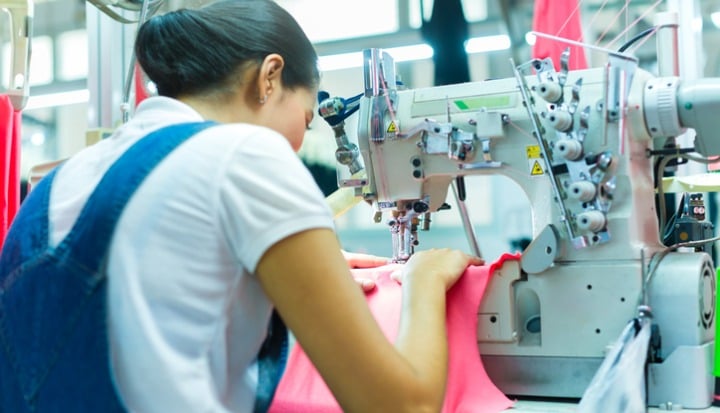As governments, businesses, civil society and NGOs take stock of global progress towards to UN Sustainable Development Goals (SDGs), it is important to recognize that investing in women in global garment supply chains can act as a lever to achieving the SDGs.
RISE: Reimagining Industry to Support Equality is an initiative to support collaborative industry action at scale to advance gender equality in global garment, footwear and home textiles supply chains. Through our close partnership with some of the world’s leading apparel brands, we know the difference that can come from a sustained commitment and investment in improving gender equality.
This Global Goals Week, I’m considering five reasons why businesses should prioritize supporting women in global garment supply chains.
1) Women workers need gender-specific support. Due to gender inequality, women workers in global garment supply chains face many challenges. Women have limited opportunities for job advancement and are under-represented in leadership positions. Women workers experience sexual violence and harassment at work. Gender-based violence and discrimination is routed in social norms that are challenging to speak about.
Women may not have decision-making powers about how to spend their money and have lack of access and knowledge of how to use financial products and services. Tailored training is needed, therefore, to support women workers in addressing specific gender inequalities.
2) Progress on gender equality is vanishing. It is a dispiriting but true fact that the collective efforts to date have not progressed gender equality as much as we would have expected.
Whilst many organizations have been working for years to increase women’s empowerment, UN Secretary General António Guterres said “progress won over decades is vanishing before our eyes,” in a speech to the Commission on the Status of Women ahead of International Women’s Day on 8 March 2023, stating “Gender equality is growing more distant. On the current track, UN Women puts it 300 years away.”
Gender bias continues to be a pervasive problem worldwide. The UNDP Gender Social Norms Index (GSNI), covering 85 percent of the global population, reveals that close to 9 out of 10 men and women hold fundamental biases against women, along four key dimensions: political, educational, economic and physical integrity.
This means we cannot stop investing as we need to regain lost ground and move forward on gender equality to meet SDG Goal 5: Achieve gender equality and empower all women and girls.
3) The supply chain depends on workers. Workers are the most disadvantaged group in the international supply chain. Without them, the supply chain will collapse. Without garment factory workers, there are no garment factories. Without garment factories there are no garments, and therefore no production or consumption, responsible or otherwise. Recognizing and supporting the role of women workers is crucial to meet SDG 12: Responsible Consumption and Production.
4) Workplace training improves lives. Improving skills and knowledge through workplace training programmes supports SDG 8: Decent Work and Economic Growth. Phan Thi Kim Quyen (Julia) is a Regional Compliance Supervisor, managing CSR activities for three factories of Yee Tung Garment Co., Ltd in Vietnam. Julia is a Peer Educator in the RISE Financial Health (previously HERfinance) program training workers on topics such as financial management, using digital financial services and saving for future goals.
“After the training, the workers grow in confidence and feel secure because they can control their finances,” Julia said. “They can cover their families’ needs and achieve their goals in the future, as well as meeting unexpected costs and emergencies e.g. hospital fees and medicine.”
Julia herself has benefitted from the RISE training. “I started working here after I graduated from university. The RISE training included presentation skills, which helped in my job, and then I was promoted to a role across three factories,” she said. “Before the training, even though I had my salary, I was not confident about finances, but now I have strong financial knowledge and have paid for a house for my mother.”
5) Businesses can catalyze industry transformation. Through working with RISE, businesses can catalyze change not only in their own supply chains but in the wider industry and policy arena. RISE goes beyond workplace programs to bring positive change to the whole industry and influence policy improvements. It includes workers’ voices and representation at every level from governance to project implementation, ensuring that the work responds to women workers’ needs and priorities. RISE has broad stakeholder involvement at its governance: brands, suppliers, labour organizations and unions, and women’s movements. This level of holistic collaboration seeks to bring system change and embodies SDG 17: Partnerships for the Goals.
Experience shows that when responsible businesses invest in their supply chains, they improve workers’ lives, strengthen the supply chain, and contribute to meeting the SDGs.
Brands, buyers and suppliers can become a member of RISE now and invest in a workplace program in their garment supply chain. Programs are currently operating in Bangladesh, China, Vietnam, Cambodia, Indonesia, India, Egypt and Pakistan.
www.riseequal.org










